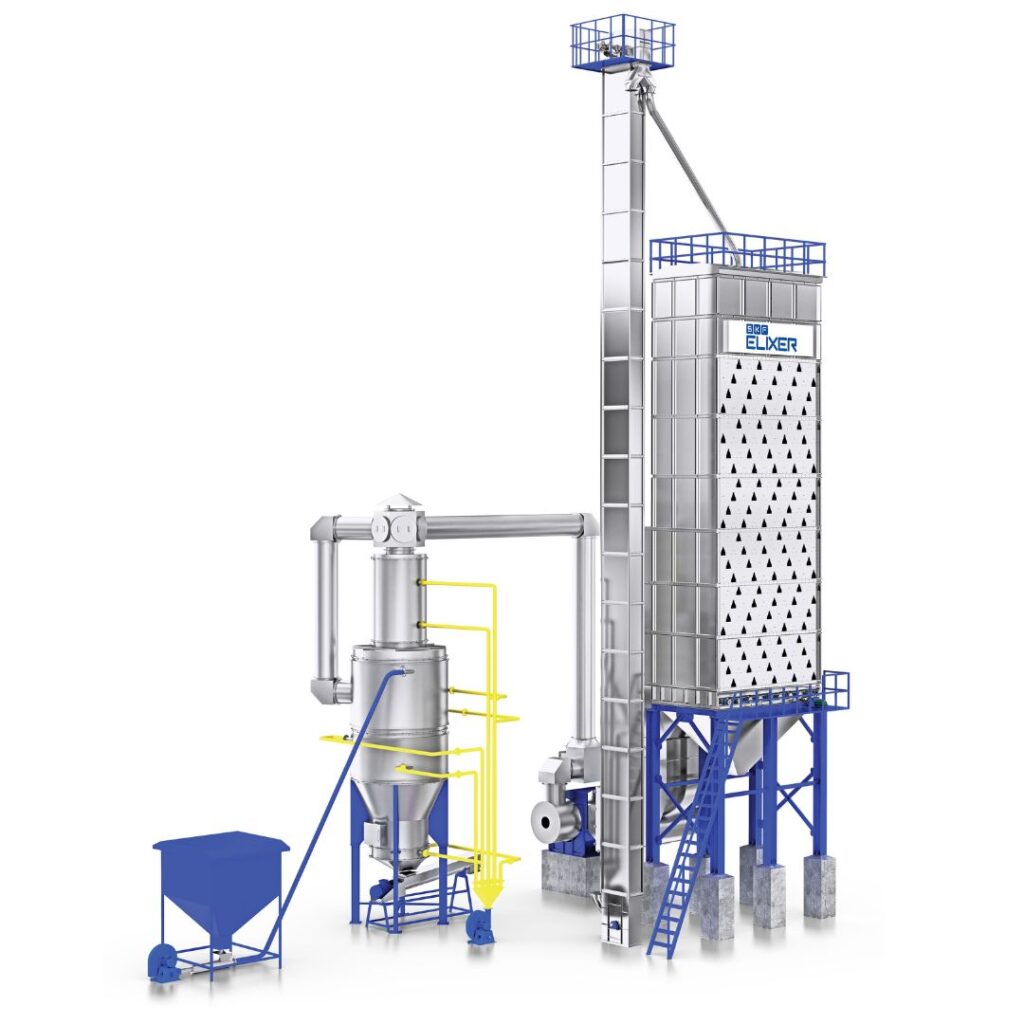Table of Contents
Drying is one of the most critical operations in the Paddy Parboiling process, and properly drying the paddy results in higher rice output. In essence, the paddy dryer utilises mechanical technology by blowing natural or heated air to evaporate excess moisture from paddy. In this blog, we’ll now break down the drying process and its economic benefits:

Good reads are meant to be shared
Process of Drying Operation In Parboiling Process
Once the final steamed paddy is fed into the dryer through the elevator, grain moves to the top of the dryer and is simply fed down by gravity and the system passes hot air through specially designed V-ports, which ensures proper mixing of the paddy and exposure to uniform hot air throughout the length of the drying chamber.
The initial moisture of paddy before entering the dryer is 32 to 36 per cent. Vfds are fitted inside to control discharge and volumetric airflow. A temperature control valve is incorporated to ensure the required temperature. In this stage, 120 degrees Celsius hot air is passed through the dryer at the initial stages.
When the paddy’s moisture content is reduced to 18%, the hot air temperature is reduced to 80 to 90 degrees Celsius, and if the paddy’s moisture content is reduced to 14 percent, the hot air temperature can be reduced to 70 to 80 degrees Celsius until the moisture drops to 12.5 percent. Once the Paddy attains the desired moisture, it is transferred to the final storage bin.
How Can the Drying Process Increase The Total Rice Yield
Parboiled paddy is more difficult to dry and requires more energy than drying raw paddy because of its high moisture content. However, higher air temperatures help reduce the drying time. Additionally, if drying is done too fast, internal stresses develop in the grain and cause breakage during milling.
Ideally, parboiled paddy should be dried to 12.5% moisture for safe storage and milling. After drying, the paddy should be allowed to stand for at least several hours – preferably for 1 or 2 days – before it is milled, to permit internal moisture differences and stresses to equalise.
Furthermore, moisture reduction takes place rapidly during the first part of drying from 36 to 18% moisture level, but is slow from 18 to 14%. The drying process should be stopped at about 12.5% moisture to allow the paddy to temper or equalize for several hours.
Benefits of Mechanical Parboiling Dryers
Consider the following key benefits of mechanical dryers:
1. The drying rate and duration are controlled to produce a better quality product
2. The operation is performed irrespective of weather conditions both in day and night
3. The process is automatic and requires minimal labour
4. Losses due to birds and rodents are eliminated
5. It requires less space for operation compared to sun-drying.
6. High amounts of grain can be handled in shorter times since drying rate is faster.
7. Uniform drying
8. Increase of headrise yield
9. Reduced manpower
10. Reduced drying time.
11. Mechanical drying efficiency ensures the least broken percentage and high nutrient value.
12. Drying process compresses the gelatinous amylase starch together in a compact mass and delocalizes it from the husk making de-husking easier.
Related: Different types of Paddy Dryers
Conclusion
To ensure better drying performance, optimum drying conditions have to be made. Maximum use of machineries and proper matching of individual processing units in plant are the most important factors in running the plant efficiently and economically.
Here are few specific objectives to consider for efficient parboiling operation
1. Design, development and testing of a your suitable dryer size.
2. Design and layout of parboiling and drying plants to match your rice mill capacity with minimum idle time of machines and better utilization and higher efficiency of the system.
Frequently Asked Question
Q 1. Why is drying an important step in the parboiling process?
A Drying is crucial because it reduces the moisture content of the parboiled paddy to a safe level for storage and milling. Proper drying ensures high rice yield, minimizes grain breakage, and enhances the quality of the final product.
Q 2. What is the ideal moisture level for parboiled paddy before milling?
A. The ideal moisture level for parboiled paddy before milling is around 12.5%. Drying the paddy to this level ensures safe storage, reduces breakage during milling, and helps achieve a high head rice yield.
Q 3. How does a mechanical dryer improve the quality of parboiled rice?
A. Mechanical dryers provide uniform drying, reduce moisture levels efficiently, and minimize the risk of uneven drying, which can cause stress cracks in the grains. ns.
Q4. What happens if the drying process is too fast or uneven?
If drying is done too quickly, internal stress develops within the grains, leading to cracks and breakage during milling. Uneven drying can cause moisture imbalance, reducing the overall quality and yield of the rice. Proper control of drying temperature and duration is essential to prevent these issues.
Good reads are meant to be shared




